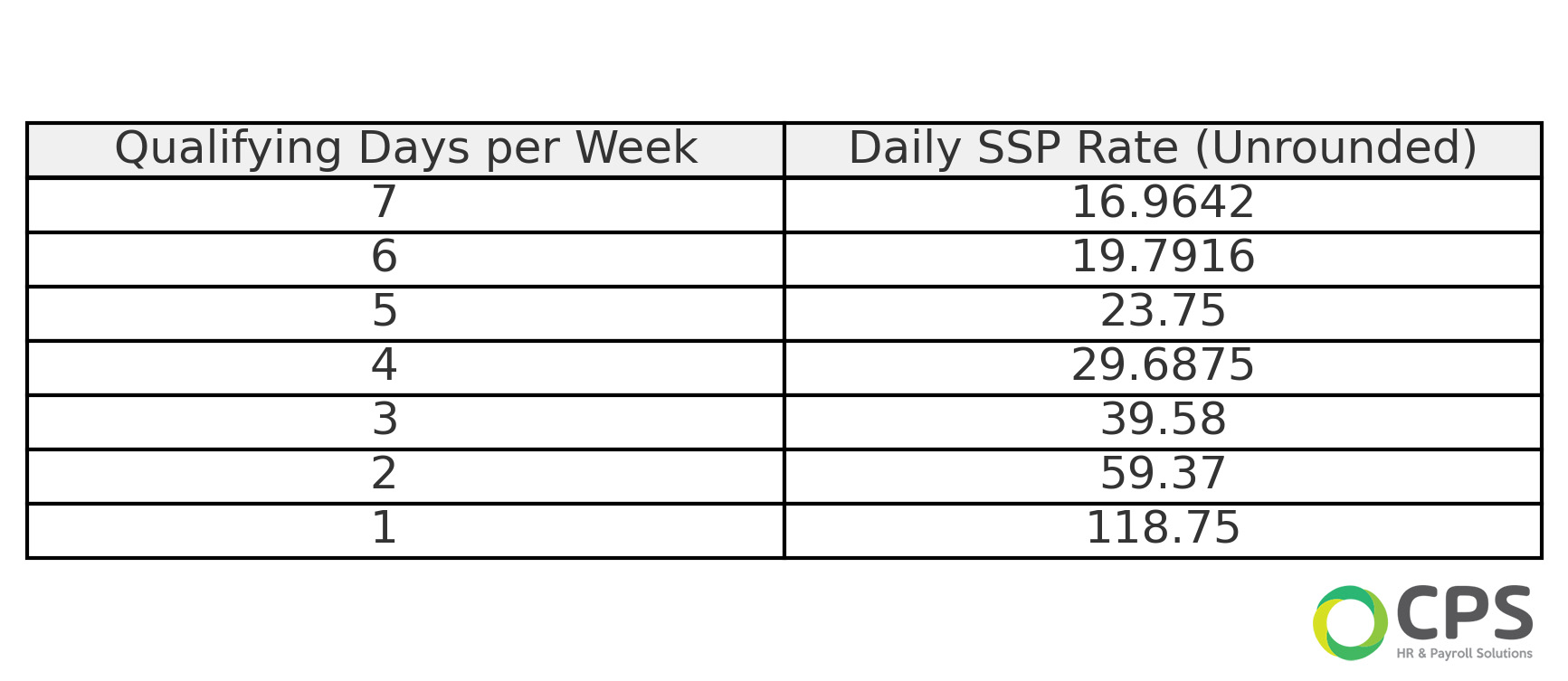Statutory Sick Pay (SSP) is a legal requirement for all employers, providing eligibility requirements are met by the relevant employee. There may be times when you need to calculate SSP manually, and here we explain how to work out sick pay and what needs to be considered and factored into the process.
This updated 2025/2026 guide reflects the latest changes to statutory sick pay rates and eligibility rules, ensuring employers remain compliant with current legislation.
Employers must ensure statutory sick pay is correctly processed in line with HMRC regulations, particularly when recording absences and tracking qualifying days.
Contents
- What is Statutory Sick Pay?
- Who is Eligible for Statutory Sick Pay?
- Who is Not Eligible for Statutory Sick Pay?
- How Much is Statutory Sick Pay?
- How is SSP Calculated in 2025/2026?
- Example: Calculating SSP for an Employee
- How is SSP Calculated for Part-Time Workers?
- Can Employees Use Annual Leave During Sick Leave?
What is Statutory Sick Pay?
Statutory Sick Pay (SSP) is the minimum amount an employer must legally pay employees who are too ill to work and meet the eligibility requirements. It is paid by employers for up to 28 weeks and applies to most types of workers, including agency staff and part-time employees.
Who is eligible for statutory sick pay?
There are a few eligibility conditions that must be met before paying SSP. Employees do not need to ‘claim’ SSP, as it should be paid by default by an employer, providing they meet the criteria and follow company procedure, which usually involves submitting a sick note from a doctor.
If Class 1 National Insurance contributions are paid to your employees, the below criteria are relevant to your business.
To claim employee’s Statutory Sick Pay, employees must:
- Have been off work for due to illness for a minimum of 4 consecutive days (this includes non-working days)
- Earn at least an average of £123 before tax is applied (2022-23)
- Inform their employer within 7 days of any deadline that has been set
This also applies to casual, agency and zero-hour workers, who can claim SSP if these conditions are met. Agricultural workers have a different scheme which you can find out more about here.
SSP is usually not paid for the first 3 days of absence, which is known as a ‘‘Period of Incapacity for Work’ (PIW)’. However, this will not apply if they have already received SSP in the previous 8 weeks which included a 3-day waiting period.

Who is Not Eligible for Statutory Sick Pay?
Not every worker will qualify for statutory sick pay. In the following cases, employers are not required to pay SSP:
- Self-employed workers who are not classed as employees.
- Employees who have already received 28 weeks of SSP within the same sickness period.
- Workers who start a new job after their sickness began.
- Anyone receiving Employment and Support Allowance (ESA) or maternity allowance.
- Employees in legal custody or on strike during the period of illness.
It’s important for employers to clearly document reasons for SSP ineligibility, especially where non-working days overlap with periods of sickness, to prevent payroll disputes.
How much is statutory sick pay?
Employees unable to work due to illness can claim Statutory Sick Pay (SSP) for up to 28 weeks, receiving at least £99.35 per week.
However, many employers offer a more generous sick pay through their own occupational schemes, which can exceed the statutory minimum.
The details of these schemes, including payment amounts and duration, are typically outlined in the employment contract. Occupational schemes aim to provide better financial support during illness, reflecting an employer’s commitment to employee welfare.
Employees should review their contract or employee handbook to understand their specific sick pay entitlements, which can help alleviate financial concerns during extended periods of illness.
How is SSP calculated in 2025/2026?
To understand how to calculate SSP you can follow these steps:
1. Check Eligibility for SSP
Employees are now eligible for SSP from the first day of sickness without the need for a waiting period. Previously, employees had to wait three days, but this has been removed starting in April 2025.
To qualify for SSP:
- Employees must be ill for at least four consecutive days.
- There is no longer a requirement for employees to meet a minimum weekly earnings threshold of £125 (previously known as the Lower Earnings Limit).
2. Determine the SSP Rate
The SSP rate has been updated to £118.75 per week in 2025/2026. Employees who are eligible for SSP can receive this amount, or 80% of their average weekly earnings, whichever is lower.
If employees earn below £125 per week, their SSP is based on 80% of their average weekly earnings rather than the statutory rate.
3. Calculate Daily SSP Amount
To calculate the daily SSP rate, you need to determine the employee’s number of qualifying days worked per week. The table below shows the updated SSP daily rates for different qualifying days.

4. Record the Number of Qualifying Days Off Sick
The next step is to record the number of days the employee was off sick. Each day of absence will be calculated using the daily SSP rate based on the number of qualifying days the employee typically works.
For example, an employee who works five days a week and is off sick for seven days will be entitled to SSP for six of those days (after accounting for the initial waiting period, which has now been removed).
5. Calculate Total SSP Entitlement
Finally, add up the daily SSP rates for all qualifying days of absence to calculate the total SSP the employee is entitled to. If an employee is sick for multiple periods, you should calculate the SSP for each period separately and combine them.
Example: Calculating SSP for an Employee
Employee Details:
- The employee works 5 days per week (Monday to Friday).
- The employee is off sick for 7 days.
- The employee’s weekly earnings are £300.
Step 1: Calculate the Daily Rate
The daily SSP rate is calculated as follows:
- £300 ÷ 7 qualifying days = £42.86 per day
Step 2: Calculate the Total SSP
For 6 qualifying days of absence (after the 3-day waiting period), the employee would receive:
- £42.86 × 6 days = £257.14 in SSP
How is SSP calculated for part-time workers?
To determine the daily rate of SSP, divide the weekly SSP rate by the total number of days the employee was off sick, based on their contracted working days.
This calculation should factor in the employee’s average weekly earnings to ensure accuracy. For example, dividing the weekly rate of £118.75 by the total sick days (nine in this scenario) provides the daily SSP rate.
Note: Starting in 2025, there is no waiting period before SSP starts, so part-time employees are eligible for SSP from the first day of sickness.
The Lower Earnings Limit (LEL), which previously required employees to earn at least £125 per week to qualify, has been removed. Employees earning below £125 per week are still entitled to SSP, calculated as 80% of their average weekly earnings.
Multiply Daily Allowance by Eligible Sick Days
The final step is to multiply the calculated daily SSP rate by the number of days the employee is eligible for SSP, excluding the waiting days. This calculation results in the total SSP amount payable to the employee during their sick leave.
Here’s a breakdown of the calculation:
Weekly Rate ÷ Total Sick Days = Daily SSP Rate
Daily SSP Rate x Eligible Sick Days = Total SSP Payable
Example calculation:
-
£118.75 ÷ 9 = £13.19 (Daily SSP Rate)
-
£13.19 x 6 = £79.14 (Total SSP Payable)
Remember, this is a manual calculation and will not be necessary if you are using a good payroll software system, as it will automatically calculate the figure once you have inputted the relevant employee sick leave information.
Ideally, the software should also be able to automatically incorporate any updates that have been made to SSP legislation, including any rate changes for the new tax year.
This process ensures that employers accurately calculate SSP based on contracted working days and average weekly earnings, maintaining compliance and fairness.
Additionally, understanding these principles can be beneficial when dealing with other statutory payments, such as statutory maternity pay (SMP), which also relies on average earnings and specific eligibility criteria.
For automated support, explore HR software which simplifies absence tracking and ensures every statutory payment is processed correctly.
Can employees use annual leave during sick leave?
Statutory holiday pay can still be accrued while they are off sick from work, so this should be taken into account with any statutory sick pay calculation.
Annual leave can also be used while an employee is on sick leave (regardless of how long they are off work). If employees are eligible for SSP, they cannot be asked to take holiday pay.
It is also a good idea to keep records when paying SSP to employees, as this can be matched with attendance records if there are any queries or disputes raised at a later date.
